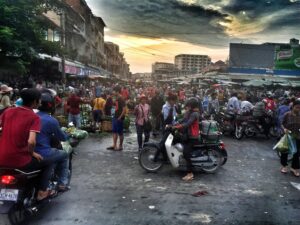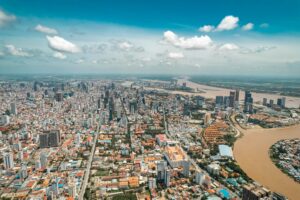Phnom Penh, the bustling capital of Cambodia, is a vibrant city with a unique blend of historical charm, modern growth, and warm hospitality. Known for its picturesque riverside views, historic temples, and lively markets, Phnom Penh offers tourists a captivating experience rich in culture and history. Here’s a complete guide to help you navigate the best attractions, dining spots, and travel tips for an unforgettable stay in Phnom Penh.
A Brief History of Phnom Penh
Phnom Penh has a storied history dating back to the 14th century. It became Cambodia’s capital in the 15th century and quickly established itself as a thriving cultural and economic center. The city, often referred to as the “Pearl of Asia,” has faced significant challenges, including the Khmer Rouge era. Today, Phnom Penh stands resilient, a vibrant metropolis that reflects Cambodia’s enduring spirit and growth. Its historical landmarks, bustling streets, and serene temples showcase the city’s evolution over centuries.
Getting to Phnom Penh
Phnom Penh is easily accessible by both international and domestic flights, making it a central hub for travelers to Cambodia. The Phnom Penh International Airport (PNH) is located about 10 kilometers from the city center, with various transportation options available:
- Taxi: Taxis are available at the airport and are a quick, straightforward way to reach the city.
- Tuk-Tuk: Tuk-tuks are an affordable and popular option among tourists. You can negotiate the fare or use local apps like PassApp for fixed pricing.
- Public Bus: Bus services are limited but offer an inexpensive option to reach central locations within Phnom Penh.
Tip: Downloading local transportation apps like PassApp will make it easier to get around.

Top Attractions in Phnom Penh
Phnom Penh is filled with attractions that showcase its cultural, historical, and architectural richness. Here are some must-visit sites:
- The Royal Palace and Silver Pagoda: This iconic landmark is the residence of Cambodia’s King and a symbol of the country’s monarchy. Visitors can explore the stunning Silver Pagoda, home to numerous historical artifacts, including the Emerald Buddha. The palace grounds are beautifully landscaped, offering an insight into Cambodian art and architecture.
- National Museum of Cambodia: Just north of the Royal Palace, this museum houses the world’s most extensive collection of Khmer art and artifacts. It’s a perfect place to learn about Cambodia’s history, with exhibits ranging from prehistoric times to the Angkorian era.
- Wat Phnom: This temple, located on a small hill, is the city’s oldest and a significant religious site. Legend has it that Phnom Penh was founded here when Lady Penh discovered sacred statues. Wat Phnom is particularly popular during Khmer New Year, offering beautiful views of the city from its elevated location.
- Tuol Sleng Genocide Museum: Formerly a school turned into a prison by the Khmer Rouge, this museum stands as a powerful memorial to the victims of Cambodia’s dark history. It provides a sobering and educational experience, shedding light on Cambodia’s resilience and determination to rebuild.
- Choeung Ek Killing Fields: Located a short drive from Phnom Penh, the Killing Fields serve as a memorial to the victims of the Khmer Rouge. The peaceful setting contrasts with its history, offering visitors a place to pay their respects and learn more about this tragic period.

Shopping and Markets in Phnom Penh
Phnom Penh’s markets are lively, colorful, and full of local treasures. Here are a few popular shopping spots to explore:
- Central Market (Phsar Thmey): Located in an iconic Art Deco building, the Central Market is perfect for finding souvenirs, jewelry, clothing, and electronics. Its unique architecture and bustling atmosphere make it a favorite among tourists.
- Russian Market (Phsar Toul Tom Poung): This market is famous for handicrafts, silk scarves, and antiques. It’s also a great place to find unique souvenirs, handmade jewelry, and artwork.
- Night Markets: The night markets along the riverside offer a range of food, clothing, and locally made products. They’re ideal for evening shopping and a taste of Cambodia’s street food scene.
Tip: Remember to negotiate prices, as bargaining is customary in Cambodian markets.

Dining in Phnom Penh
Phnom Penh’s culinary scene is diverse, offering everything from traditional Khmer dishes to international cuisine. Here are a few must-try foods and popular dining areas:
- Khmer Cuisine: Try classic Cambodian dishes like amok (coconut curry fish), bai sach chrouk (pork and rice), and nom banh chok (Khmer noodles). For authentic Khmer cuisine, restaurants like Malis and Friends the Restaurant are highly recommended.
- Street Food: Street food is a must for adventurous eaters. Try local favorites like num pang (Cambodian sandwiches) and fried banana. Riverside food stalls and the Russian Market are popular spots for sampling street food.
- International Cuisine: Phnom Penh also has a range of international restaurants. The Boeung Keng Kang (BKK) area is well-known for its variety of cafes and eateries serving everything from Italian to Japanese.

Getting Around Phnom Penh
Navigating Phnom Penh is relatively easy thanks to various transportation options:
- Tuk-Tuks: Tuk-tuks are a convenient way to get around the city. Apps like PassApp and Grab make it easy to book rides and see fares in advance.
- Motorbike Rentals: For a more flexible experience, motorbike rentals are available, but keep in mind that Phnom Penh’s traffic can be chaotic. A Cambodian driver’s license is typically required.
- Bicycles: For a leisurely way to see the city, bicycles can be rented at many hotels and guesthouses.
Tip: Be cautious when navigating traffic, as the roads can be busy, especially during peak hours.
Best Time to Visit Phnom Penh
Phnom Penh has a tropical climate with warm temperatures year-round. The ideal time to visit is between November and February, when the weather is cooler and drier. March to May can be very hot, while June to October is the rainy season, although showers are usually short and don’t disrupt travel plans.
Staying Safe and Healthy
- Vaccinations: Recommended vaccinations include hepatitis A, typhoid, and rabies. Make sure your tetanus shots are up-to-date.
- Water: Avoid drinking tap water and opt for bottled or filtered water instead.
- Travel Insurance: It’s advisable to have travel insurance that covers health emergencies, as quality medical care can be costly.
- Street Safety: Phnom Penh is generally safe, but like any big city, it’s wise to be cautious. Keep your belongings secure and avoid poorly lit areas at night.
Tip: Use mosquito repellent to avoid mosquito-borne illnesses like dengue fever, which is common in tropical regions.
Day Trips from Phnom Penh
Silk Island (Koh Dach): A short boat ride from Phnom Penh, Silk Island is known for its traditional silk weaving. Visitors can watch local artisans work and buy handmade silk products directly from the source.
Oudong Mountain: Once the capital of Cambodia, Oudong Mountain is home to ancient stupas and offers beautiful panoramic views. It’s a popular day trip for those interested in history and nature.
Tonle Bati: Located south of Phnom Penh, Tonle Bati is a peaceful lakeside area with ancient temples like Ta Prohm and Yeay Peau. It’s a great escape from the city’s hustle and bustle.

Nightlife in Phnom Penh
Phnom Penh has a lively nightlife scene with a mix of bars, clubs, and cultural performances:
- Riverside: The riverside area along Sisowath Quay is home to many bars, cafes, and restaurants with views of the Tonle Sap and Mekong Rivers. It’s a popular spot for evening relaxation.
- BKK1 and Bassac Lane: These neighborhoods are known for their trendy bars, lounges, and live music venues. Bassac Lane, in particular, is a hidden gem with small, unique bars offering craft cocktails.
- Apsara Dance Shows: Experience traditional Khmer culture with an Apsara dance performance, a classical dance form unique to Cambodia. Many venues offer dinner shows, combining culture and cuisine.
Final Thoughts: Embracing the Spirit of Phnom Penh
Phnom Penh is a city that honors its past while embracing the future. From majestic temples and historical sites to bustling markets and dynamic nightlife, it’s a city that offers something for every traveler. Whether you’re exploring the quiet charm of its pagodas, sampling street food, or learning about Cambodia’s resilient history, Phnom Penh will leave an unforgettable impression. Use this guide to make the most of your visit to Cambodia’s captivating capital and discover the beauty of Phnom Penh, a city where tradition meets modernity.
